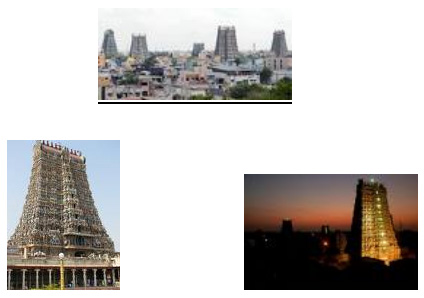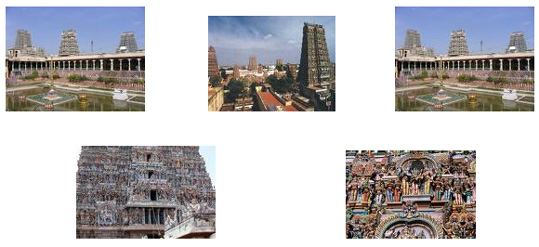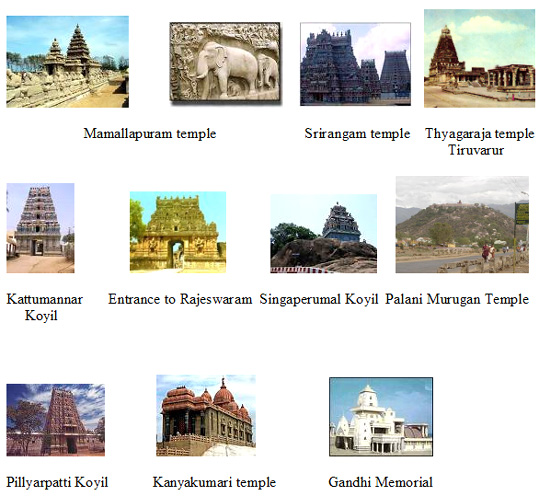TEMPLES AND TEMPLE COMPLEXES OF TAMIL NADU

Peppered across the state of Tamil Nadu are approximately 1,000 Hindu temples. These were constructed over the span of 2,000 years, most have stood the test of time and are architectural marvels. They are fine examples of Dravidian style of temple building. Although invading Muslim rulers had routinely destroyed Hindu, Buddhist and Jain temples, since such invasions usually came through the northwestern parts of India, the brunt of such destruction was borne by North Indian structures. Some old South Indian temples were, however, destroyed but most escaped damage. Also, later construction used granite, and these withstood serious damage. While some new large temples have been constructed, architecturally outstanding structures were from the distant past. Two of these deserve special mention: first, the temple complexes called “Madurai Meenakshi AmmanTemple” in Madurai and secondly, the “Periya Koyil” at Thanjavur, the latter built by the Chola ruler Raja Raja Chola I the Great.
South Indian temples follow one general pattern. The main structure, having the inner sanctum with the deity, is usually the tallest. This is called the gopuram or tower. Sometimes a temple is a conglomerate of several gopurams, each devoted to a different deity. A good example of this is the Madurai Meenakshi temple. The temple compound is surrounded by a wall and one or more gates. In the Madurai Meenakshi temple compound are four gates, in each of the four cardinal directions. The following article will devote more space and will list and display pictures of the most important temples of Tamil Nadu (the Madurai Meenakshi Amman temple and the Periya Koyil of Thanjavur)
and highlight only the special features of some of the other temples. Of course, it is impossible and unnecessary to show or list all of the hundreds of temples in Tamil Nadu.
MEENAKSHI AMMAN TEMPLE OF MADURAI:
This complex of temples is the most famous of the Hindu temples of Tamil Nadu. Although the exact date of construction of these temples is not known, but it is believed that the initial structure was constructed as early as 2,500 years ago and it had been mentioned in Tamil literature since antiquity. As is the usual habit of invading Muslims, the initial structures were gutted by Malik Kafur in 1310 AD. They were then rebuilt by the efforts of Arya Natha Mudaliyar, the then Prime Minister of the first Nayak of Madurai in 1,600 AD. While the name suggested that the temple is dedicated to Meenakshi (Parvathi, the consort of Lord Shiva), Lord Shiva’s shrine seems to have more importance. It is at the center and is larger, while Meenakshi’s shrine is to the left and is smaller.
There are fourteen elaborately carved and imposing gopurams, of which the south gopuram is the tallest. It stands 170 ft high (52m). The outline of all the gopurams follow a similar pattern and were constructed using granite. The base is rectangular and the gopurams slightly taper as they rise but do not end in a point as the Egyptian pyramids do. Thus, they are rhomboid structures. The outer faces of the gopurams carry exquisite carvings of deities, animals, scenes from the Epics etc. All of them have also been painted with appropriate colors. All of the gopurams impress one with the size as well as the artistry exhibited in the carvings.

As usual, inside the temple compound is a large (165x120ft) man-made pond (“Parthamarai Kulam” or “Pond with the golden lotus”). The devotees usually circumambulate this lake and some of them bathe in it before entering the shrine. The thousand pillar hall is a special feature of Madurai Meenakshi temple and is in itself a stunning example of Dravidian architecture, with elaborate carvings in granite, again depicting deities and scenes from the Hindu Epics.

Visitors to Meenakshi temple usually return awestruck by the artistry and industriousness that made possible the construction of not only the gopurams but this elaborately carved pillared hall. Some believe this temple is worthy of consideration as one of the wonders of the world.
PERIYA KOYIL:
In Tamil language Periya means large and Koyil is a synonym for temple. And, true to its name, this temple is a large and imposing structure. It was constructed by Raja Raja Chola I the great. Not only is the temple itself tall and exquisitely carved, at the magnificence of the large dome at the top of the structure is awe-inspiring. No one knows exactly how the granite blocks used in the construction or the dome was transported to the top of the temple. Each of the granite slabs weighed about 40 tonnes and granite was not available anywhere near the site of the temple. Archaeologists have discovered remnants of a slope of approximately 6degrees, and in the direction of the Periya Koyil and they have deduced that the blocks and the dome were transported on wooden logs, and pulled and pushed by strong elephants. However this was accomplished, one is awestruck by the magnitude of the endeavor and the sheer magnificence. This masterpiece is almost as important as the Madurai Meenakshi temple as a prime tourist destination in Tamil Nadu.

IMAGES OF SOME OTHER TEMPLES OF TAMIL NADU:

Winner of the 7 Wonders of India: Meenakshi Temple!
7 Wonders of India: Thanjavur Chola Temple